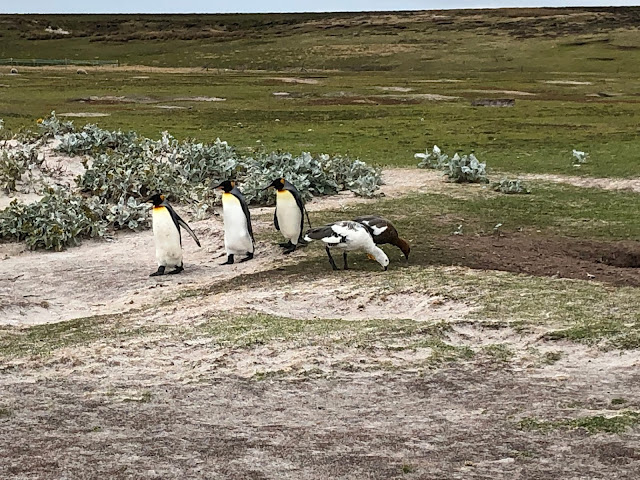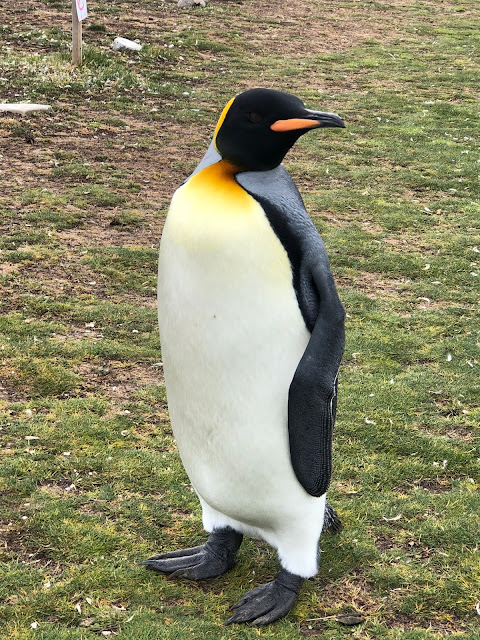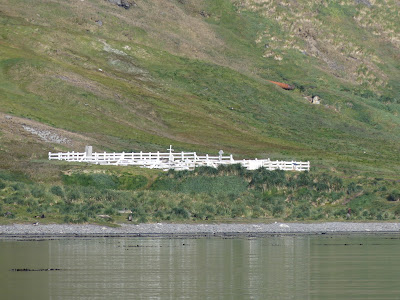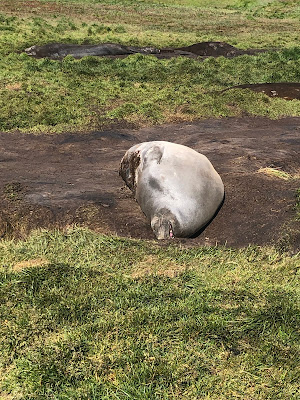South Georgia Island and the South Sandwich Islands are a British Overseas Territory. On South Georgia Island, there are no permanent residents, only a revolving group of scientists and other maintenance personnel who take up temporary residence for a year or two.
Grytviken is the main settlement area where the scientists and support staff live and conduct their science work studies. It began as a whaling station, and that came about because Ernest Shackleton and his crew from the Endurance landed here in 1916. Sir Shackleton's grave is also here in the cemetery; his remains were posthumously sent here after he died of a heart attack in 1922, at his request. Shackleton mentioned the huge numbers of seals and whales here after he returned home and it was because of this that soon ships arrived to hunt and kill the whales and seals. They nearly decimated both populations during the long decades they were here. Operations were finally shut down in 1964.
It takes a lot of preparation and red tape to visit Grytviken. We only received the permit to come ashore 4 days prior to our actual visit. We also had to undergo bio-security training and our clothing, shoes, backpacks and other outerwear needed to be scanned, cleaned and approved before we could collect a shore pass. We did this preparation the two days before we reached the Island. A mandatory attendance for the training was held first, then the next day we presented ourselves and our items for inspection. Once approved and cleaned, we had to then sign an affidavit and finally, collect a shore pass. We would each be allowed only 2 hours onshore. Tender operations would be in effect and you couldn't get on a tender until your time slot said you could. Once ashore, the 2 hour window began.
The time went by quickly, but it was plenty of time to visit the cemetery where Shackleton and about 200 others are buried, the quaint church, the museum and to see the rusty remains of much of the whaling station. Oh, and there were a large number of seals, elephant seals molting, and some penguins. It was wonderful!!!
Our expedition team said that a visit to this tiny island is a "rare treat that few get to experience." I'm so glad I am part of that group.
Views early in the morning as we sailed into the bay
Sunrise about 5:00 AM!
The little settlement of Grytviken
The cemetery at Grytviken
Shackleton's grave
View of the cemetery, below, from the ship
In the church, there's a bust of Shackleton, above
The church. Isn't this a lovely setting? By the way, the weather we had here was one of only about 5 days in the entire summer where it was this clear, not windy, and you can see the mountain tops.
In the back of the church is a small room that contains the library. The books are still here, from when the whalers lived and worked.
I even got to ring the church bells!
There is a (small, er, tiny) post office!!
We also visited the museum. It has a replica of Shackleton's small boat that he and 3 of his team used to sail about 800 miles from Elephant Island to get help for his crew, left back at Elephant Island. It took them 15 days in incredible stormy seas to reach South Georgia Island. Can you even imagine spending 15 days with 3 other people in this tiny little boat?
These albatross have huge wing spans! They are amazing birds. One of our expedition team gave a lecture on the albatross. There are 23 different species of these birds, and 19 of them, yes - 19 - are in danger of becoming extinct. One of the amazing abilities albatrosses have is the ability to soar - it's the ability to increase altitude without flapping wings. They do what is called dynamic soaring - the harness the variation in horizontal winds.

Below is Mrs. Chippy, a beloved cat that went along on one of the exploration trips. Mrs. Chippy was actually a male tabby, and brought on board by the carpenter named Harry "Chippy" McNish. This cat followed McNish around everywhere, and also proved to be quite the sailor - climbing the riggings, being able to walk along the narrow rails of the ship without falling, etc. Along the way, in 1915, Shackleton decided that several of the dogs on board as well as Mrs. Chippy would not make the remainder of the journey and ordered them shot. McNish never forgave his captain for Mrs. Chippy's "demise." McNish died in New Zealand in 1930 and was buried with full military honors, and in 2004, the government of New Zealand, through donations, put a life-size bronze statue of Mrs. Chippy next to McNish's headstone to memorialize the beloved cat and McNish's devotion to him. Being an avid animal lover, I was most touched by this story. Even Snort shed a little tear when told about Mrs. Chippy and McNish.

Another shot of the small boat, Caird.
This shot, below, is a picture of the smallest man on the exploration team, and the largest dog!
The men ate food from these tins while at sea and on their land expeditions.
This is a tent set-up that Scott (I believe) used after having landed on Antarctica. The tent is a pyramid shape, which made it possible to withstand hurricane force winds and the blizzards the men had to endure while trekking across Antarctica. The tent's design remained throughout the exploration years, as it was very efficient.
I always love a good "alert" sign, because we need more lerts in the world. Bahahahaha! My Daddy first said this to me when I was a kid and I've always remembered it and loved it. When I saw this in the museum here in Grytviken, where Shackleton is also buried, I thought that maybe my Dad was here with me in spirit. He really loved reading about Shackleton and Scott and the other explorers who sailed to Antarctica. He left me his books about these voyages and encouraged me to read them. A good Navy man, he loved anything to do with ocean/sailing adventures.

It's penguin and seal time on Grytviken! There were tons of fur seals on the island, as well as Antarctic elephant seals, who were in the middle of molting. The elephant seals we saw were all teenagers -- the adults get more than double the size of the younger ones. I thought they were already big enough, so it was hard to imagine them growing even more. Most of the fur seals we saw were also youngsters, and were quite friendly, curious and playful. There were some King penguins too, but not as many as what I saw in the Falklands, a few days later.
An elephant seal, molting. Looks and is rather painful for them. It takes a tremendous amount of energy to molt, and they get quite fussy as a result.
Doesn't he look pitiful? Poor guy.
But Mom, why can't we go play with our friends???
Some seal antics
Come on in! The water's great!!
What did I tell you about talking to strangers???
I see you. Even with one eye, I see you!
Linda, our cruise director, being a human "cone" for the day. The ship had some crew trained ahead of time, to be path monitors, to make sure guests didn't stray outside the safe areas.
Some of the old buildings and equipment from the days of whaling
Travel quote: "Live, travel, adventure, bless and don't be sorry" -- Jack Kerouac
Stay tuned for more Pig Tales!



















































































































